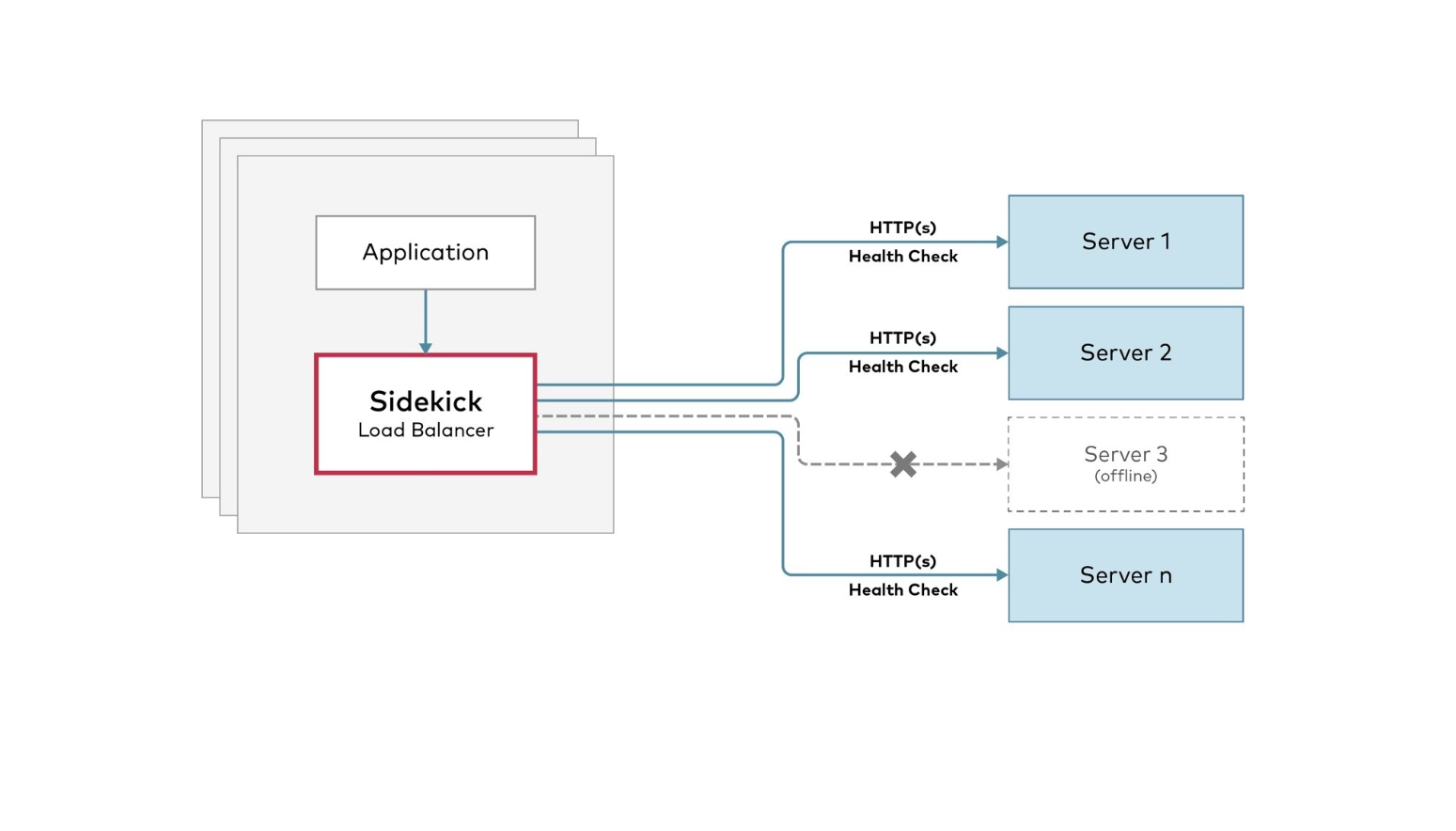Minio Sidekick Save
High Performance HTTP Sidecar Load Balancer

sidekick is a high-performance sidecar load-balancer. By attaching a tiny load balancer as a sidecar to each of the client application processes, you can eliminate the centralized loadbalancer bottleneck and DNS failover management. sidekick automatically avoids sending traffic to the failed servers by checking their health via the readiness API and HTTP error returns.
Architecture

Demo 
Install
Binary Releases
| OS | ARCH | Binary |
|---|---|---|
| Linux | amd64 | linux-amd64 |
| Linux | arm64 | linux-arm64 |
| Linux | ppc64le | linux-ppc64le |
| Linux | s390x | linux-s390x |
| Apple | amd64 | darwin-amd64 |
| Windows | amd64 | windows-amd64 |
You can also verify the binary with minisign by downloading the corresponding .minisig signature file. Then run:
minisign -Vm sidekick-<OS>-<ARCH> -P RWTx5Zr1tiHQLwG9keckT0c45M3AGeHD6IvimQHpyRywVWGbP1aVSGav
Docker
Pull the latest release via:
docker pull quay.io/minio/sidekick:v4.0.6
Build from source
go install -v github.com/minio/sidekick@latest
You will need a working Go environment. Therefore, please follow How to install Go. Minimum version required is go1.17
Usage
NAME:
sidekick - High-Performance sidecar load-balancer
USAGE:
sidekick COMMAND [COMMAND FLAGS | -h] [ARGUMENTS...]
COMMANDS:
help, h Shows a list of commands or help for one command
FLAGS:
--address value, -a value listening address for sidekick (default: ":8080")
--health-path value, -p value health check path
--read-health-path value, -r value health check path for read access - valid only for failover site
--health-port value health check port (default: 0)
--health-duration value, -d value health check duration in seconds (default: 5s)
--insecure, -i disable TLS certificate verification
--log, -l enable logging
--trace value, -t value enable request tracing - valid values are [all,application,minio] (default: "all")
--quiet, -q disable console messages
--json output sidekick logs and trace in json format
--debug output verbose trace
--cacert value CA certificate to verify peer against
--client-cert value client certificate file
--client-key value client private key file
--cert value server certificate file
--key value server private key file
--help, -h show help
--version, -v print the version
Examples
Load balance across a web service using DNS provided IPs.
$ sidekick --health-path=/ready http://myapp.myorg.dom
Load balance across 4 MinIO Servers.
http://minio1:9000 to http://minio4:9000
$ sidekick --health-path=/minio/health/ready --address :8000 http://minio{1...4}:9000
Load balance across 2 sites with 4 servers each
$ sidekick --health-path=/minio/health/ready http://site1-minio{1...4}:9000 http://site2-minio{1...4}:9000
Realworld Example with spark-operator
With spark as driver and sidecars as executor, first install spark-operator and MinIO on your kubernetes cluster.
Configure spark-operator
This guide uses the maintained spark operator by GCP at https://github.com/GoogleCloudPlatform/spark-on-k8s-operator.
helm repo add spark-operator https://googlecloudplatform.github.io/spark-on-k8s-operator
helm --namespace spark-operator install spark-operator spark-operator/spark-operator --create-namespace --set sparkJobNamespace=spark-operator --set enableWebhook=true
Install MinIO.
Ensure that the standard storage class was previously installed.
Note that TLS is disabled for this test. Note also that the minio tenant created is called myminio.
helm repo add minio-operator https://operator.min.io/
helm install operator minio-operator/operator --namespace minio-operator --create-namespace
helm install myminio minio-operator/tenant --namespace tenant-sidekick --create-namespace && \
kubectl --namespace tenant-sidekick patch tenant myminio --type='merge' -p '{"spec":{"requestAutoCert":false}}'
Once the tenant pods are running, port-forward the minio headless service to access it locally.
kubectl --namespace tenant-sidekick port-forward svc/myminio-hl 9000 &
Configure mc and upload some data. Use mybucket as the s3 bucket name.
Create bucket named mybucket and upload some text data for spark word count sample.
mc alias set myminio http://localhost:9000 minio minio123
mc mb myminio/mybucket
mc cp /etc/hosts myminio/mybucket/mydata.txt
Run the spark job in k8s
Obtain the ip address and port of the minio service. Use them as input to fs.s3a.endpoint the below SparkApplication. e.g. http://10.43.141.149:80
kubectl --namespace tenant-sidekick get svc/minio
Create the spark-minio-app yml
cat << EOF > spark-job.yaml
apiVersion: "sparkoperator.k8s.io/v1beta2"
kind: SparkApplication
metadata:
name: spark-minio-app
namespace: spark-operator
spec:
sparkConf:
spark.kubernetes.allocation.batch.size: "50"
hadoopConf:
"fs.s3a.endpoint": "http://10.43.141.149:80"
"fs.s3a.access.key": "minio"
"fs.s3a.secret.key": "minio123"
"fs.s3a.path.style.access": "true"
"fs.s3a.impl": "org.apache.hadoop.fs.s3a.S3AFileSystem"
type: Scala
sparkVersion: 2.4.5
mode: cluster
image: minio/spark:v2.4.5-hadoop-3.1
imagePullPolicy: Always
restartPolicy:
type: OnFailure
onFailureRetries: 3
onFailureRetryInterval: 10
onSubmissionFailureRetries: 5
onSubmissionFailureRetryInterval: 20
mainClass: org.apache.spark.examples.JavaWordCount
mainApplicationFile: "local:///opt/spark/examples/target/original-spark-examples_2.11-2.4.6-SNAPSHOT.jar"
arguments:
- "s3a://mybucket/mydata.txt"
driver:
cores: 1
memory: "512m"
labels:
version: 2.4.5
sidecars:
- name: minio-lb
image: "quay.io/minio/sidekick:v4.0.3"
imagePullPolicy: Always
args: ["--health-path", "/minio/health/ready", "--address", ":8080", "http://myminio-pool-0-{0...3}.myminio-hl.tenant-sidekick.svc.cluster.local:9000"]
ports:
- containerPort: 9000
protocol: http
executor:
cores: 2
instances: 4
memory: "1024m"
labels:
version: 2.4.5
sidecars:
- name: minio-lb
image: "quay.io/minio/sidekick:v4.0.3"
imagePullPolicy: Always
args: ["--health-path", "/minio/health/ready", "--address", ":8080", "http://myminio-pool-0-{0...3}.myminio-hl.tenant-sidekick.svc.cluster.local:9000"]
ports:
- containerPort: 9000
protocol: http
EOF
Grant permissions to access resources to the service account
kubectl create clusterrolebinding spark-role --clusterrole=edit --serviceaccount=spark-operator:default --namespace=spark-operator
kubectl create -f spark-job.yaml
kubectl --namespace spark-operator logs -f spark-minio-app-driver
Monitor
The above SparkApplication will not complete until the Health check returns "200 OK"; in this case when there is MinIO read quorum. The Health check is provided at the path "/v1/health". It returns "200 OK" even if any one of the sites is reachable, else it returns "502 Bad Gateway" error.


